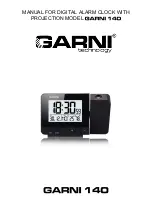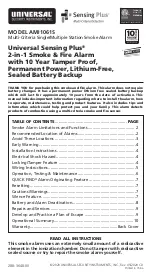
b) Batteries/rechargeable batteries
• Please observe the correct polarity when placing batteries/rechargeable batteries
in the unit.
• If you are not going to use the device for a while, remove the batteries/recharge-
able batteries to prevent damage from leaking. Leaking or damaged batteries/
rechargeable batteries can cause acid burns upon contact with the skin. Thus,
you should wear protective gloves when handling damaged batteries/recharge-
able batteries.
• Keep the batteries/rechargeable batteries out of the reach of children. Do not lea-
ve batteries lying around, as they may be swallowed by children or pets.
• Do not dismantle batteries/rechargeable batteries, do not short-circuit them and
do not throw them into fire. Never charge conventional, non-rechargeable batte-
ries. There is a danger of explosion!
Control Elements
1 Time display
6 ▼ button
2 “Mode” button
7 Calendar display
3
button
8 Alarm display
4
button
9 Battery compartment
5 ▲button
Inserting/Replacing Batteries/Rechargeable Batteries
• Swing open the support bracket at the back of the housing.
• Slide the lid of the battery compartment downward and remove it.
• Insert two AAA/micro batteries, observing the correct polarity. The correct polarity is indicated
in the battery compartment (9).
• Immediately after inserting the batteries, the radio clock will start searching for the DCF signal
(see also section “DCF Reception”).
• Close the battery compartment (9) again.
• Replacing the batteries is necessary when the battery warning symbol appears on the dis-
play.
Use of rechargeable batteries is possible. However, due to lower operating voltage
(rechargeable battery = 1.2 V, battery 1.5 V) and lower capacity the operating time
will be less.
DCF reception
Immediately after the batteries are inserted, the device makes the first attempt to receive the
DCF signal. While the device is attempting to receive the DCF signal, the radio tower symbol
flashes in the time display (1). After successfully receiving the DCF signal, the time (1) is auto-
matically set to the current time and the radio tower symbol is shown continuously.
The detection and interpretation of the DCF signal can take about 3-5 minutes. Do
not move the radio-controlled alarm clock during this time. Do not press any buttons
or switches!
You may face bad signal reception due to, for example, metallised insulated glass,
reinforced concrete buildings, coated special wallpapers, proximity to electronic de-
vices, or in cellars.
If the correct time is not shown after 10 minutes, move the radio clock to another
location, remove the batteries and re-insert them after about 10 minutes. Then the
alarm clock starts a new attempt to receive the signal as described above.
The reception attempt for the daily automatic synchronisation with the DCF time is done seve-
ral times a day. One successful reception per day is sufficient to keep the deviation to less than
one second.
The DCF signal is transmitted via a DCF transmitter in Mainf-
lingen (near Frankfurt am Main). Its range covers up to 1500
km and, and under ideal reception conditions, even up to
2000 km.
Among other things, the DCF signal includes the precise
time (theoretical deviation of 1 second in a million years!)
and the date.
Naturally, this also eliminates the hassle of manually setting
up summer and winter times.
1500 km
2000 km
Operating instructions
Radio alarm clock EFW 220
Item no. 1486095
Intended use
The product is intended for displaying the time of day; in addition, there is an integrated alarm
function and date display. The time and date are set automatically using an integrated DCF
receiver.
The product must only be operated with batteries. No other electrical power supply is permitted.
The product may only be used in enclosed indoor locations. Outdoor use is not allowed. Con-
tact with moisture, for example in bathrooms or the like, must be avoided.
For safety and approval reasons, you may not convert and/or alter the product. If you use the
product for purposes other than those described above, the product may be damaged. Further-
more, improper use can cause risks such as short-circuits, fire, etc. Please read the operating
instructions carefully and do not discard them. If you pass the product on to a third party, please
hand over these operating instructions as well.
This product complies with the applicable national and European regulations. All names of
companies and products are the trademarks of the respective owners. All rights reserved.
Package Contents
• Radio alarm clock
• 2x AAA batteries
• Operating instructions
Up-to-date operating instructions
Download the latest operating instructions via the link www.conrad.com/downloads or scan the
QR code. Follow the instructions on the websit
Explanation of Symbols
An exclamation mark in a triangle indicates important instructions in this operating
manual which absolutely have to be observed.
The arrow symbol is used when specific tips and information on handling are provi-
ded.
Safety Instructions
Please read the operating instructions carefully and pay particular attention to
the safety instructions. We do not assume liability for injuries/material damag-
es resulting from failure to observe the safety instructions and the information
in these operating instructions regarding the proper handling of the product.
Furthermore, in such cases, the warranty/guarantee will be null and void.
a) General
• The product is not a toy. Keep out of the reach of children and pets.
• Do not leave packing materials unattended. It may become a dangerous plaything
for children.
• Protect the product from extreme temperatures, direct sunlight, strong vibrations,
high humidity, moisture, combustible gases, vapours and solvents.
• Never expose the product to mechanical stress.
• If safe operation is no longer possible, take the device out of service and secure
it against unintended use. Safe operation is no longer possible, if the product:
- has visible damage,
- no longer functions properly,
- has been stored under adverse ambient conditions for an extended period of
time or
- has been exposed to considerable strain during transport.
• Please handle the product carefully. It can be damaged by impact, blows, or by
being dropped, even from a low height.
• Please consult a specialist if you have any doubts regarding the use or safety of
the product.
• Maintenance, adjustment and repair work may be carried out only by an expert or
a specialist workshop.
• If you have any questions that are not answered in these operating instructions,
please contact our technical customer service or other professionals.


























